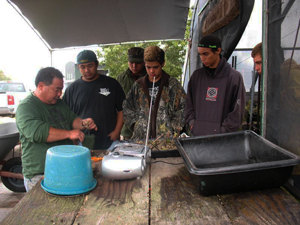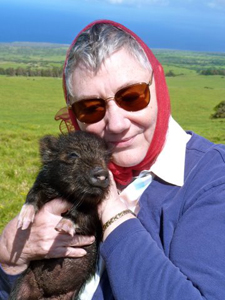 Photo: “While driving up to Pu‘u Kehena, Professor Vitousek jumped out of the jeep, raced up the pu‘u and caught a baby pig. He is a local, country boy at heart who can live off the land and I am so proud of him. We all learned so much from him that day.” –Cindi Punihaole. Here Aunty Arline J. O'Brien cuddles the wild piglet. Photo by Michael O’Brien.
Photo: “While driving up to Pu‘u Kehena, Professor Vitousek jumped out of the jeep, raced up the pu‘u and caught a baby pig. He is a local, country boy at heart who can live off the land and I am so proud of him. We all learned so much from him that day.” –Cindi Punihaole. Here Aunty Arline J. O'Brien cuddles the wild piglet. Photo by Michael O’Brien.
“Professor Peter Vitousek told us that this area of the Puanui Ahupua‘a is a ‘sweet spot’ where our kūpuna, working closely with, caring for, respecting, and understanding nature, prepared the ‘āina (land) and reaped bountiful crops to adequately sustain the people of Kohala for hundreds of years,” reports Cindi Punihaole.
Having lived in Korea for thirty four years I know much about the dust storms from the Gobi Desert. We called them ‘The Yellow Winds’ in Korea. Some years we got dumped on in Seoul, so badly that dust got in your eyes, ears, nose, and between your teeth. I knew that this silt got as far as Wyoming, but I never thought those winds deposited nutrients in the soils of Hawai‘i Island and still do, to a certain degree. The Kohala Field System from ‘Upolu Point to the plains of Waimea is amazing! –Michael O`Brien

Photo: The group lending their hands in the garden at Puanui. Photo by Michael O’Brien.
Harvests from Puanui have supported events such as the Ka Waimea Makahiki, Pu‘u Kohola Cultural Festival, and have fed others in the community, including those who have volunteered time at Puanui. “As we've developed our collection, we've served as a source of clean planting material for ‘uala (tubers). We don't yet have many ‘uala pests, so the propagation material is good for sharing,” says Aurora K. Kagawa, Research Assistant for the Puanui Project.
View a webcast of Professor Vitousek’s Puana Ka ‘Ike (Imparting Knowledge) lecture presentation on March 26, 2010, at The Kohala Center’s Puana Ka ‘Ike Lecture Series Web site at http://kohalacenter.org/puanakaike/webcasts10.html.

New Thinking for Hawai‘i and the World
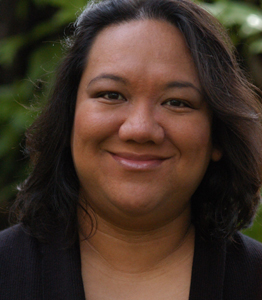
Arista has a capacious and original intellect and a knack for seeing familiar sources and problems in wholly new ways. Her stunning dissertation, ‘Histories of Unequal Measure,’ expands the boundaries of early American history, reaching into the Pacific, to London, and beyond. ‘Histories of Unequal Measure’ forces us to rethink the ways North American history and Hawaiian history have intersected with and shaped one another over time.
–Dr. Jane Kamensky, Professor of History and Women and Gender Studies at Brandeis University and Arista’s mentor for the dissertation
Dr. Jane Kamensky compared Dr. Noelani Arista’s work to an earlier Nevins Prize winner, Willie Lee Rose, who won the prize in 1963. “Rose's pioneering ‘Rehearsal for Reconstruction’ brought African-American history into the mainstream of modern American thought. Her book was a finalist for the National Book Award and won the Francis Parkman Prize when it was published in 1965. The Allan Nevins Prize launched Rose's brilliant career, one of the most important of the 20th century. 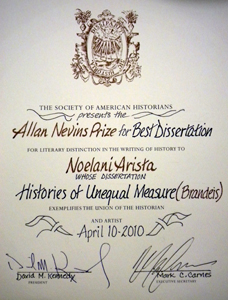 I expect we'll say the same thing about Arista in the 21st century," Kamensky said.
I expect we'll say the same thing about Arista in the 21st century," Kamensky said.
“Thanks to the trustees of Kamehameha Schools and The Andrew W. Mellon Foundation, and to Dr. Hamabata and the rest of the diligent staff at The Kohala Center, I was able to finish my dissertation in time in order to qualify for this prestigious national history prize,” Arista said. “I think this bodes very well for mainstreaming Hawaiian scholarship into broader fields and disciplines, like American History. It speaks volumes about the support that the Mellon-Hawai‘i Fellowship and The Kohala Center can provide in supporting up-and-coming scholars such as myself, who are seeking their education beyond our shores, and in disciplines that do not, at first glance, seem to support a space for Hawaiian scholarship!”
The granting of the Allan Nevins History Prize for the best doctoral dissertation on an American subject validates our interest in supporting the development of intellectual leadership from Hawai‘i—for Hawai‘i and the world. It is extremely rewarding to see young Hawaiian thinkers and writers enliven the academy with the vitality of indigenous perspectives and indigenous scholarship.
–Robert Lindsey, Jr., Chairman of the Fellowship’s Senior Advisory Board
Read "A Hawaiian Way of Seeing the World,” a brief autobiographical profile by Noelani Arista, in the February 2009 issue of The Leaflet.

Hoping To Make a Difference
By Roya Sabri, junior at Kealakehe High School and
2010 CATALYST Academy scholarship recipient
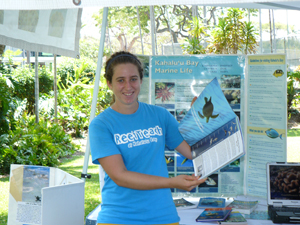 Photo: Roya Sabri ReefTeaching at the Outrigger Keauhou Beach Resort’s 40th Anniversary celebration in March. Photo by Caroline Neary.
Photo: Roya Sabri ReefTeaching at the Outrigger Keauhou Beach Resort’s 40th Anniversary celebration in March. Photo by Caroline Neary.
Creating unity between nature and culture has been my passion for more than three years. I have the wonderful opportunity to live on the Island of Hawai‘i. However, as in any area with unique ecology and human colonization, there are conflicts between the needs of a growing population and the needs of the native Hawaiian ecology. Hawai‘i is the only island on earth to have all of the six major biomes: freshwater, marine, desert, forest, grassland, and tundra. Yet 90% of the native dryland forest (the major ecosystem on the island) has been lost due to unsustainable human activities. I have spent many weekends pulling invasive weeds and reforesting desolate areas that used to be native forest—areas which provided biological diversity and resources for the native Hawaiians and the foundation for a rich culture.
Ignorance about the environment creates disunity between man and nature. I have realized that efforts to restore forest areas without working with others and educating others are useless. Only with an educated, caring, and interconnected public can we create a unified connection between man and nature and a sustainable society, in which we work together with nature, not against it. Recently, I have become more involved in the education of the public in order to facilitate this unity.
I joined ReefTeach hoping to make a difference in the development of Hawai‘i’s unique coral reefs by facilitating a deeper level of understanding about our relationship with the coral reef. By participating in ReefTeach, I have not only had the opportunity to talk to members of the community and tourists about the state of the coral reefs, but I have been able to gain insight into the relationships that others have with Hawai‘i’s natural environment.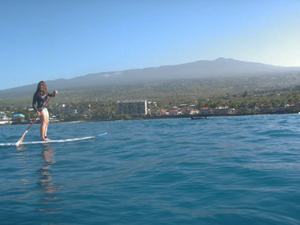
We are all so fortunate to live on an island so unique, with a diverse representation of species which we can learn so much from. If we care about the life of this island, as well as the life of our society, we need to change the mindset of our culture. ReefTeach is a good start for the initiation of this reform.
Through my observations and research in environmental sciences, I have come to realize that the process of integrating human civilization with nature has not always been sustainable. Of the sciences, engineering is in one of the best positions to reinstate sustainability. Engineering is a branch of science which thinks critically about the state of human kind and integrates the needs and knowledge from other disciplines of science to design something effective and efficient.
At the CATALYST Academy, I wish to explore the disciplines of engineering and apply my skills as a scientist and artist to integrate nature and culture sustainably and harmoniously. I am sure that my experience at the CATALYST Academy will be a major stepping stone into my future as an innovative engineer.

Honoka‘a High School Agriculture Teacher Manuel Jadulang has been the FFA Club Advisor at the school for the past three years. Club members meet during lunch and after school hours. “This club is important because it allows students to belong to an organization with others who have similar aspirations and interests,” says Jadulang. “The Club provides expanded learning opportunities for its members beyond the regular school day, as well as leadership training. They also get to go on field trips, camping trips, and to the state convention,” he says.
Photo: Horticulturist Baron Horiuchi showed students how to transplant Hawaiian mint seedlings. (From left to right) Baron Horiuchi, James Maikui, Keleb Panglinawan, Kaliko Pajimola, Kaniela Heincke and James Marlin.I set up this trip so students can actually see some of the topics that I teach about in the classroom firsthand. Students got to see a real Native Hawaiian rainforest and they learned about the importance of this forest. They also got to give back to the ‘āina by working in the greenhouse at the refuge, and they saw rare native birds.
–Manuel Jadulang, Honoka‘a High School FFA Club Advisor
The National FFA Organization was founded in 1928. Jadulang is not sure when the Honoka‘a Chapter was formed, but he has found award plaques and photo scrapbooks in his classroom dating back to the 1940s. Currently, there are three active FFA chapters on Hawai‘i Island, at Honoka‘a, Kea‘au, and Pahoa High Schools.

